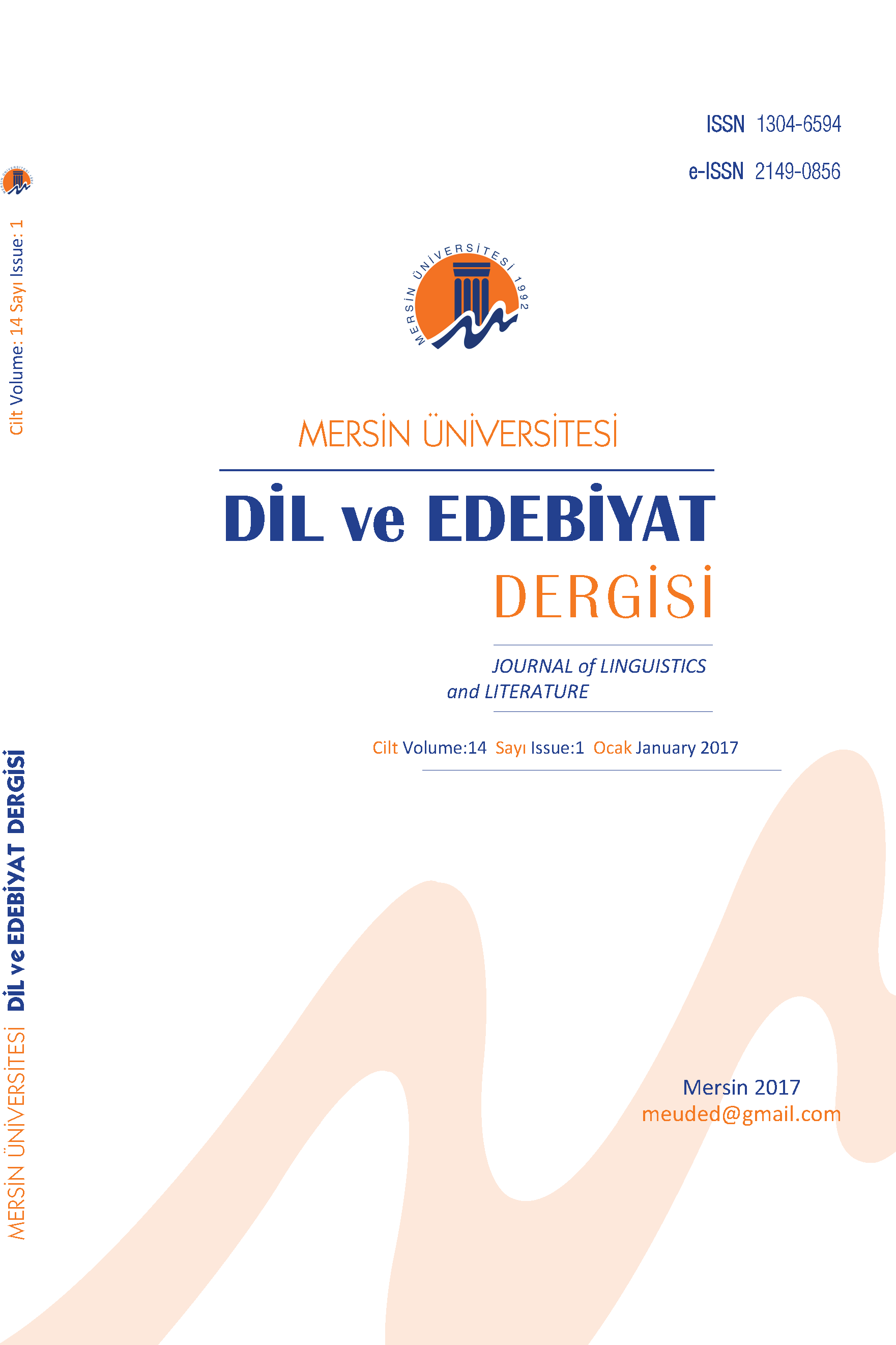Türkçede Ad Anlambilimi ve Sayı Belirleme
Bu çalışma, Türkçede adların anlambilimi ve adsal sayı belirlenmesini incelemektedir. Türkçede adlar İngilizce gibi dillerdeki muadillerinden önemli ölçüde farklı davranmaktadırlar. Özellikle, çıplak olarak ve herhangi bir sayı belirlemesi olmadan bulunabilirler ve sayı adları ve niceleyicileri ile birlikte aynı ortalarda bulunduklarında çoğul eki almazlar. Burada sorulan sorular, Türkçede adların neden bu şekilde davrandıkları ve gösterdikleri özelliklerin sistemli bir biçimde açıklanıp açıklanamayacağıdır. Önceki çalışmalarda bu sorulara çok değinilmemiştir çünkü odak noktası genelde adlarla sıfatların benzerlik ve farklılıkları ile adların sözlüksel bir kategori oluşturup oluşturmadığıdır. Bu çalışmada, Türkçede adların yalnızca sözlüksel bir kategori oluşturmakla kalmayıp, anlamsal ve morfolojik-sözdizimsel bakımdan da Rijkhoff'ta (2002ab, 2008) ortaya atılan ve adsal bir alt kategori olan küme adları özelliklerine sahip oldukları gösterilmektedir. Bu açıklama ayrıca Türkçede çoğul özne ve eylem arasında görünen sayı uyumu ve uyumsuzluğunu da izah etmektedir.
Anahtar Kelimeler:
Noun semantics, Bare nouns, Number marking, Turkish
Noun Semantics and Number Marking in Turkish
This study is concerned with the semantics of nouns as a distinct syntactic category and the marking of nominal number in Turkish. The question addressed is why Turkish nouns behave in a way that is significantly different from their counterparts in languages like English and Chinese. Specifically, why are bare nouns allowed in Noun Phrases (NPs) where they are not specified for number and why are they not pluralized when they co-occur with numerals? In order to address these issues, I propose a lexical semantic account, based on Rijkhoff (2002ab, 2008), and argue that Turkish nouns belong to the nominal subcategory of set nouns that have their unique lexical properties. The observed distinctions in their semantics and grammatical marking stem from those characteristics. This analysis also makes it possible to account for verbal number discord and lack thereof in Turkish and in other languages.
Keywords:
Noun semantics, Bare nouns, Number marking, Turkish,
___
- Acquaviva, P. (2005). The morphosemantics of transnumeral nouns. Morphology and Linguistic Typology, Online Proceedings of the Fourth Mediterranean Morphology Meeting, (pp. 21-23).
- Aikhenvald, Y. A. (2000). Classifiers. A typology of noun categorization devices. Oxford: Oxford University Press.
- Bale, A. Gagnon M. & Khanjian. H. (2011). Cross-linguistic representations of numerals and number marking. N. Li and D. Lutz (eds.), Proceedings of the Twentieth Semantic Analysis and Linguistic Theory, (pp. 582-598).
- Bamyacı, E. Häussler J. & Kabak, B. (2014). The interaction between animacy and number agreement: An experimental investigation. Lingua, 148, 254-277.
- Banguoğlu, T. (1986). Türkçenin Grameri. Ankara: Dil Tarih Kurumu.
- Bliss, H. (2004). The semantics of the bare noun in Turkish. In I. Mezhevich and M. B. Dobrovolsky (eds.) Calgary Papers in Linguistics 25, 1-65.
- Corbett, G. (2000). Number. Cambridge: Cambridge University Press.
- Ergin, M. (2001). Türk dil bilgisi. İstanbul, Bayrak Basım Yayın Tanıtım.
- Goodman, N. (1966). The structure of appearance. (Second Edition). Indianapolis: Bobbs-Merrill.
- Göksel, A. & Haznedar, B. (2007). Remarks on compounding in Turkish. Part of the MorboComp Project. University of Bologna.
- Grønbech, K. (1936). Der Turkische Sprachbau I. Kopenhagen: Levin-Munksgaard.
- Hundius, H. & Kölver U. (1983). Syntax and semantics of numeral classifiers in Thai. Studies in Language 7(2), 165-214.
- Ketrez, N. (2004). –lAr marked nominals and three types of plurality in Turkish. Proceedings of Chicago Linguistic Society, 39, 176-192.
- Lucy, A. J. (1992). Grammatical categories and cognition: a case study of the linguistic relativity hypothesis. (Studies in the social and cultural foundations of language 13). Cambridge: Cambridge University Press.
- Nillson, B. (1985). Case marking semantics in Turkish. Department of Linguistics. University of Stockholm.
- Özyıldız, D. (2017). Quantification in Turkish. In D. Paperno & E. Keenan (Eds.), Handbook of Quantifiers in Natural Language. Vol. 2, (pp. 857-937). Springer.
- Rijkhoff, J. (2002a) The noun phrase. Oxford University Press.
- Rijkhoff, J. (2002b). Verbs and nouns from a cross-linguistic perspective. Rivista di Linguistica, (14)1, 115-147.
- Rijkhoff, J. (2008). On flexible and rigid nouns. Studies in Language, 32(3), 727-752.
- Schroeder, C. (1999). The Turkish nominal phrase in spoken discourse. Turcologica 40. Wiesbaden: Harratssowitz.
- Seifart, F. (2009a). Towards a typology of unitization. Miraña noun classes compared to noun classifiers and singulatives. Manuscript. Max Planck Institute for Evolutionary Anthropology, Leipzig.
- Seifart, F. (2009b). Multidimensional typology and Miraña class markers. New Challenges in Typology: Transcending the borders and refining the distinctions. Patience Epps & Alexandre Arkhipov (eds.), Trends in Linguistics Studies and Monographs 217 (pp. 365-385). Berlin: Mouton de Gruyter.
- Sezer, E. (1978). Eylemlerin çoğul öznelere uyumu. Genel Dilbilim Dergisi. Ankara Dilbilim Çevresi Derneği, Ankara, 25-32.
- Swift, B. L. (1963). A Reference Grammar of Modern Turkish. Uralic and Altaic Series, v. 19. Indiana University Press: Bloomington.
- Uygun, D. (2007). Lexical Categories in Turkish. Ms. Boğaziçi University.
- Uygun, D. (2009). A split model for category specification: lexical categories in Turkish. (Unpublished doctoral dissertation). Boğaziçi University, İstanbul.
- Wiese, H. (1997). Semantics of Nouns and Nominal Number. In ZAS Papers in Linguistics. Center for General Linguistics, Typology and Universals, 8, 136-163.
- ISSN: 1304-6594
- Yayın Aralığı: Yılda 2 Sayı
- Başlangıç: 2004
- Yayıncı: Mersin Üniversitesi
